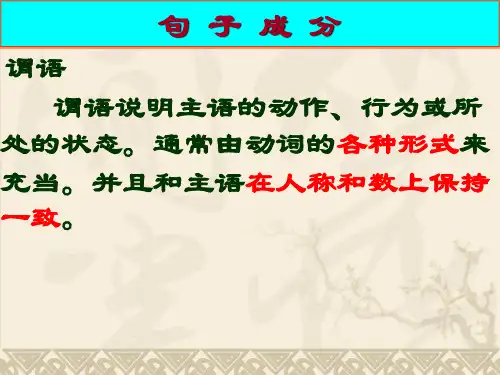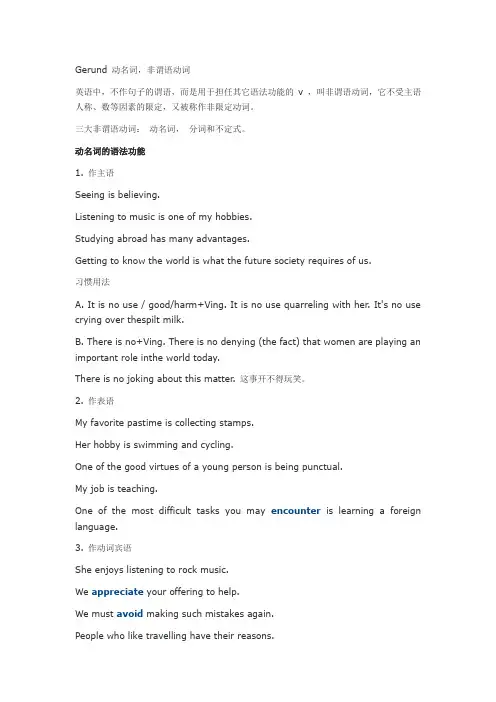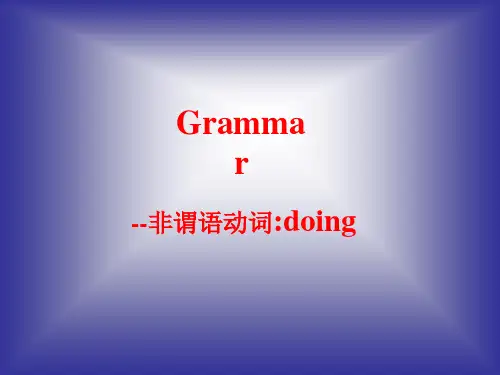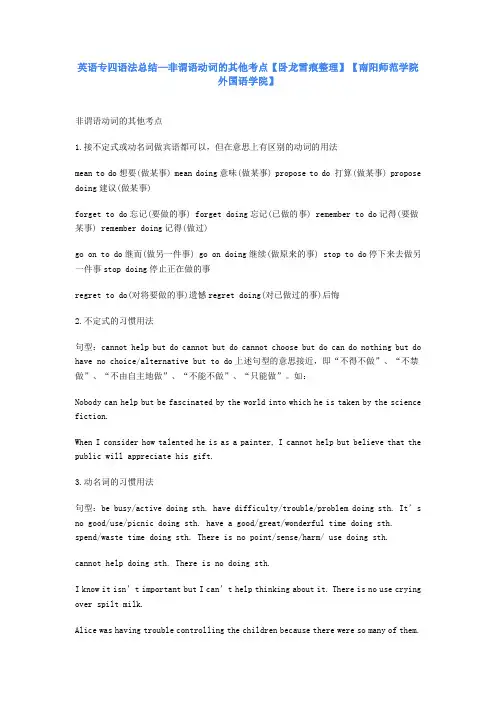[高考]专四语法非谓语动词
- 格式:ppt
- 大小:202.00 KB
- 文档页数:39




Gerund 动名词,非谓语动词英语中,不作句子的谓语,而是用于担任其它语法功能的v ,叫非谓语动词,它不受主语人称、数等因素的限定,又被称作非限定动词。
三大非谓语动词:动名词,分词和不定式。
动名词的语法功能1. 作主语Seeing is believing.Listening to music is one of my hobbies.Studying abroad has many advantages.Getting to know the world is what the future society requires of us.习惯用法A. It is no use / good/harm+Ving. It is no use quarreling with her. It's no use crying over thespilt milk.B. There is no+Ving. There is no denying (the fact) that women are playing an important role inthe world today.There is no joking about this matter. 这事开不得玩笑。
2. 作表语My favorite pastime is collecting stamps.Her hobby is swimming and cycling.One of the good virtues of a young person is being punctual.My job is teaching.One of the most difficult tasks you may encounter is learning a foreign language.3. 作动词宾语She enjoys listening to rock music.We appreciate your offering to help.We must avoid making such mistakes again.People who like travelling have their reasons.跟动名词作宾语的v.及v. phrase常见的能跟动名词作宾语的v.及v. phrase:admit, appreciate, avoid, confess to, consider, delay, deny, endure(忍耐), enjoy, escape,excuse, fancy(想象), finish, forbid, imagine, mind, miss, permit, postpone, practice,risk, can't help, feel like, give up, keep out, object to (反对), oppose, put off(推迟).注意:动名词作宾语后面带有补语,一般不用形式宾语it。




英语专四语法总结—非谓语动词的其他考点【卧龙雪痕整理】【南阳师范学院外国语学院】非谓语动词的其他考点1.接不定式或动名词做宾语都可以,但在意思上有区别的动词的用法mean to do想要(做某事) mean doing意味(做某事) propose to do 打算(做某事) propose doing建议(做某事)forget to do忘记(要做的事) forget doing忘记(已做的事) remember to do记得(要做某事) remember doing记得(做过)go on to do继而(做另一件事) go on doing继续(做原来的事) stop to do停下来去做另一件事stop doing停止正在做的事regret to do(对将要做的事)遗憾regret doing(对已做过的事)后悔2.不定式的习惯用法句型:cannot help but do cannot but do cannot choose but do can do nothing but do have no choice/alternative but to do上述句型的意思接近,即“不得不做”、“不禁做”、“不由自主地做”、“不能不做”、“只能做”。
如:Nobody can help but be fascinated by the world into which he is taken by the science fiction.When I consider how talented he is as a painter, I cannot help but believe that the public will appreciate his gift.3.动名词的习惯用法句型:be busy/active doing sth. have difficulty/trouble/problem doing sth. It’s no good/use/picnic doing sth. have a good/great/wonderful time doing sth. spend/waste time doing sth. There is no point/sense/harm/ use doing sth.cannot help doing sth. There is no doing sth.I know it isn’t important but I can’t help thinking about it. There is no use crying over spilt milk.Alice was having trouble controlling the children because there were so many of them.4.there be 非谓语动词的用法(1)做宾语时取决于谓语动词的持续要求。


英语专业四级语法重点汇总English英语专八专四学习复习资料英语专四语法重点汇总一、非谓语动词的主要考点1. 有些典型动词后面可以接上不定式或动名词来做宾语的,但是在意思上是有区别的,主要常考到的动词罗列如下:mean to do想要(做某事)VS mean doing意味(做某事)propose to do 打算(做某事)VS propose doing建议(做某事)forget to do忘记(要做的事)VS forget doing忘记(已做的事)remember to do记得(要做某事)VS remember doing记得(做过)go on to do继而(做另一件事)VS go on doing继续(做原来的事)stop to do停下来去做另一件事VS stop doing停止正在做的事regret to do(对将要做的事)遗憾VS regret doing(对已做过的事)后悔2. 不定式的习惯用法典型句型整理如下:如:“cannot help but do”——“不得不做某事”如:“cannot but do”——“不禁做某事”如:“cannot choose but do”——“不由自主地做某事”如:“can do nothing but do”——“不能不做某事”如:“have no choice but to do”——“只能做某事”如:“have no alternative but to do”——“只能做某事”例句:The boy cannot help but be greatly influenced by the useful instruction given by his family tutor.When I start my job career, I cannot choose but look back upon the beautiful days I spent on campus.3. 动名词的习惯用法典型动名词的习惯句型整理罗列如下:如:be busy/active doing sth.如:It’s no good/use doing sth.如:spend/waste time doing sth.如:have difficulty/trouble/problem doing sth.如:have a good/great/wonderful time doing sth.如:There is no point/sense/harm/ use doing sth.例句:There is no use crying over spilt milk.(典型例句)牛奶洒了,哭也没用;后悔是没有用的;覆水难受I really have problem solving these mathematic questions since I am not major in science after all.二、形容词与副词及其比较级1. 形容词的句法功能形容词通常在句子中用做定语、表语与主语的语法成分,通常考到的知识点总结如下:(1) 以“a”开头的形容词如“alone”、“alike”、“asleep”、“awake”等一般不能做前置定语,通常是做表语或后置定语的例句:Jerry didn’t pass the important final exam, please let him alone for the time being.Michael came back from job just now, and his eyes were shut and he seemed to have fallen asleep.(2) 某些以副词词缀“-ly”结尾的词其实是形容词,不能看错是副词,例如“friendly”、“leisurely”、“lovely”等(3) 下列动词既是实义动词又是系动词,注意用做系动词时,要求形容词做表语这些典型单词罗列如下:“remain”、“keep”、“become”、“get”、“grow”、“go”、“come”、“turn”、“stay”、“stand”、“run”、“prove”、“seem”、“appear”、“look”等例句:The situation remains tense between the two countries at this juncture. 在这个节骨眼上,两国形势仍然持续紧张。

Unit 1 非谓语动词非谓语动词,又叫非限定动词,在句中不能单独充当谓语(但可以和情态动词或助动词一起充当谓语),它们不受主语的限定,没有人称和数的变化,具有名词、形容词和副词的特征,在句中可以充当主语、宾语、表语、定语、状语、补足语等(除谓语外的其他各种成分)。
同时非限定动词也保留了动词的部分特征,有时态和语态的变化,也可以有自己的宾语、表语、状语等,构成非限定动词短语,在逻辑意义上也有其动作的执行者或承受者,叫非限定动词的逻辑主语(Logical Subjects)。
在历年的专四考试中,非谓语动词的考查占了相当大的比重。
1.非谓语动词做主语:(1)不定式和动名词在句中可以做主语,分词不可以。
(2)不定式一般表示具体或一次性动作,而动名词则表示一般或抽象的动作。
eg: Smoking is prohibited(禁止)here.这里禁止抽烟。
(抽象)It is not very good for you to smoke so much.你抽这么多烟对你身体很不好。
(具体) (3)不定式和动名词都可以用it来代替作形式主语,但在含有no, -lese等否定词的句子里,常用动名词作主语。
eg: It is useless talking with her.It is no good discussing with her.(4)如果主语和表语都是非谓语动词,两种应保持同样的形式,或同为不定式,或同为动名词。
eg: To see is to believe.Seeing is believing.(5)非谓语动词的否定式是直接在非谓语动词前加noteg: Not being tall is not a serious disadvantage in life.2.非谓语动词作宾语:(1)不定式和动名词在句中可以做宾语,分词不可以。
二者的区别在于:前者往往表示“未完成的”或者“未发生的动作”,而后者则表示“已完成的”或“已发生的”动作。
专四语法考点串讲之三:非谓语动词考点1:不定式专四题中对于不定式用法的考察比较少,特别是近些年的考题几乎已经不考了。
以前的考点基本集中在:(1)考察哪些动词接不定式;(2)考察哪些短语接不带to的不定式;1)can’t help/choose but do不得不,只能,不禁2)why not do sth1._______him tomorrow?2001A.Why not to call onB.Why don’t call onC.Why not calling onD.Why not call on3)would do rather than do1.She said she would work it out herself,______ask me for help.1993A.and not toB.but notC.and prefer notD.rather than(3)考察短语"be believed/said to do sth"的用法;1.The Minister of Finance is believed____of imposing new taxes to raise extra revenue.2004A.that he is thinkingB.to be thinkingC.that he is to thinkD.to think2.AIDS is said______the number-one killer of both men and women over the past few years in the region.2002A.beingB.to beC.to have beenD.having been3.Professor Johnson is said____some significant advance in his research in the past year.1999A.having madeB.makingC.to have madeD.to make(4)考察动词不定时的时态和语态:进行式to be doing,完成式to have done;一般式被动语态to be done;完成式被动语态to have been done。
第二节非谓语动词一、非谓语动词(Non-Finite Verbs)的用法非谓语动词主要有三大类:分词(Participle)、不定式(Infinitive)和动名词(Gerund)1.非谓语动词作主语(Non-Finite Verb Used as Subject)1)不定式和动名词可以在句中充当主语,但分词却不可以。
不定式一般表示具体或一次性动作,而动名词则表示一般或抽象的多次动作。
2)不定式和动名词都可以用it来代替做形式主语。
动名词常用在“It is no use/no good/fun/a waste of time/a good pleasure等名词+doing”结构和”It is useless/nice/good/interesting/worthwhile等形容词+doing”结构中作主语。
3)动名词可在“T here is (was) no +doing”结构中作主语。
4)不定式虽然不能有自己的主语,但在意思上仍有履行该动作的人或物,称为逻辑主语,动词不定式逻辑主语可用for/of引导。
当不定式和它的逻辑主语有被动关系时,不定式就需要用被动形式。
2.非谓语动词作宾语(Non-Finite Verb Used as Object)1)有些动词后只能接动名词(或名词)作宾语,如:abandon, admit,advocate, acknowledge, enjoy, escape, excuse, appreciate, risk, pardon, resist, forgive, forbid, mind, tolerate, suggest, save等。
有些动词短语后也要跟动名词作宾语,如:c an’t stand, can’t help, feel like, give up, put off等。
在have difficulty/trouble/a problem/a hard time/fun/a good time (in) +动名词;there is no point (in) + 动名词等结构中,动名词作介词in的宾语,in常省去。